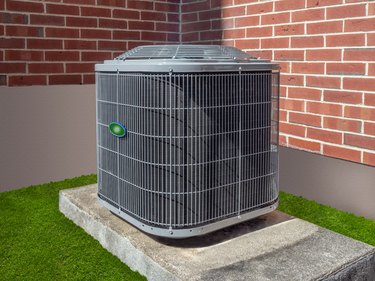
For nearly a century, California's Rheem Manufacturing has made quality home heating and cooling products among other things. With a century of products, there are many kinds of Rheem air conditioners, and troubleshooting your Rheem depends on which model you have. Some common issues can be deduced by the capable DIYer before calling in the pros, and you should refer to your owner's manual for advice specific to your model.
Rheem Air Conditioner Basics
Video of the Day
The air conditioners made by Rheem are large central air conditioners, and issues that affect them are common to most air conditioners: The unit isn't cooling adequately, it's too loud, the motor isn't running, or the condenser isn't operating. Depending on the era and type of unit you have, dozens of error codes can give you some information on what's wrong and why, but you'll need to refer to your model's owner's manual for unit-specific information.
Video of the Day
Numerous issues can be caused by incorrect energy distribution or low voltage, and many of the troubleshooting scenarios involve using a multimeter to ensure the electrical continuity is occurring as required. Without a multimeter on hand, you'll be hard pressed to ascertain what's gone awry. If a power outage occurred recently, you'll probably need to reset your Rheem air conditioner because the system protected itself from a power surge.
Common Cooling-Failure Issues
One job for a multimeter is when you suspect the contactor could be a problem, which is one of the most common causes for systems going wonky. A defective contactor fails to convert the low-voltage signal from the furnace control board into power supply for the condensing unit components. In this instance, a multimeter can detect if the contactor is failing to deliver electrical continuity. If so, the contactor may need replacement.
Other power-supply issues detectable by a multimeter include condenser fan motors not running correctly. A multimeter can tell if the condenser fan motor is getting sufficient voltage. If it's not getting enough voltage, that's a problem to solve, but if power is adequate and it's still not running, that could indicate capacitor issues. If checking out the capacitor seems to indicate that it's fine, replacing the condenser fan motor is the likely solution.
Defective capacitors are quite commonly indicated by a noisy fan motor, overheating, or just not running at all. If so, you'll need to check if it's either bulging or leaking. Any bulging or leaking means the capacitor's day is done, and replacement is required. A multimeter can also detect whether the refrigerant-circulating compressor is failing. An open circuit can indicate malfunction, and this is a replacement job that needs to be completed by a licensed technician.
Central Air: Loud or Noisy
Screws can be tightened, but that means they often come loose too, and that is often the cause behind central air units becoming loud and starting to rattle. The condenser fan blade has one such screw; if the fan blade is loose, the condenser fan motor shaft will wiggle when you give it a nudge. If so, replace or tighten the setscrew. If that doesn't help, the fan blade may need to be replaced.
The condenser fan motor itself can also be problematic, as it contains bearings that inevitably fail over the years. If you can't turn the condenser fan motor by hand when the unit isn't running, the bearings may need to be replaced.
Error Codes Are Not Always Errors
It can be exasperating to look at your unit and see would-be error codes displaying. Some, like "L4," indicate bigger issues, like a locked rotor because the protector circuits were tripped four consecutive times. It can indicate seized bearings, a bad run capacitor, low voltage, or excessive refrigerant.
Other codes just mean the system is doing regular maintenance, like a "D" being a defrost cycle, which is critical for smooth operation and happens routinely.
Dozens of error codes have been used by Rheem over the years, which is why it's necessary to refer to your owner's manual for specific error code meanings and how to address them. Of course, if troubleshooting gets to be too much for you, professionals are just a phone call away. Meanwhile, be sure you know the ins and outs of common air conditioner owner maintenance because it may keep your system running for years longer.